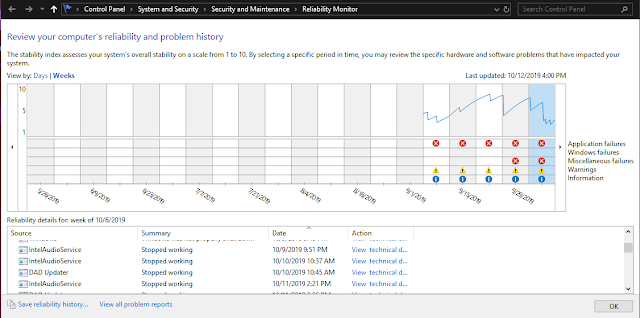So, here's a tool I didn't know about until now ("now" being when I initially wrote this post in...October?). Windows Reliability Monitor; You can find it by searching (Click the Windows icon and just start typing!)
There are no errors between May 2019 and September 1st 2019:
You'll see IntelAudioService and "Stopped Working" under summary.
That is probably the one issue I have truly had with this laptop - The audio will randomly stop. It's nothing a restart can't rectify, but now I know to simply restart the service.
However, a simple restart of the service causes it to die immediately again. This is attributed to a bug in a Windows Update that apparently hasn't been fixed since last year.
With so many available audio options in the Device Manager, it was difficult deciding which name IntelAudioService was hiding beneath. More research said it's Intel(R) Smart Sound Technology.
That name is up for debate.
I downloaded Lenovo's System Update and installed their Audio Drivers after uninstalling Intel's; After a restart, Intel's were back and Lenovo's were installed, but not anywhere I could find them.
We can mark this problem tentatively 'solved'.
That was in November! It's December, and another issue started - Sound would only work if my headphones were in.
Found out that...for some reason, System Sounds was disabled, and somehow that had something to do with it.
Also, the sound would work on Steam (Not here) and not on Youtube videos. Firefox was probably muted too. But we shall see.
Other notes;
It usually happens with my Bluetooth headphones, and usually in public places. I'd say 'Bluetooth Interference',but I don't have the problem with my Android phone being connected to it, and it's fairly recent.
In retrospect, sometimes it does struggle to play my podcasts on my phone without skipping severely, which also happens on the laptop occasionally.
The Bluetooth instances happened after I rolled back the Windows 1904 update. Previously, the crashing sound driver was maybe once a week.
So, if you have any recommendations for wired earbuds, please, comment below!
There are no errors between May 2019 and September 1st 2019:
- I did not get this laptop until July 2019, and it was refurbished. So, either the monitor doesn't go back more than 5 months, or this machine was returned and wiped and sat in storage for months until I bought it.
- The numbers on the far left indicate a health score - 10 is best. The problems make the score start at 5.
- An update between September 1st and 15th caused some things to not update, including an Intel driver, but we're all good now.
You'll see IntelAudioService and "Stopped Working" under summary.
That is probably the one issue I have truly had with this laptop - The audio will randomly stop. It's nothing a restart can't rectify, but now I know to simply restart the service.
However, a simple restart of the service causes it to die immediately again. This is attributed to a bug in a Windows Update that apparently hasn't been fixed since last year.
With so many available audio options in the Device Manager, it was difficult deciding which name IntelAudioService was hiding beneath. More research said it's Intel(R) Smart Sound Technology.
That name is up for debate.
I downloaded Lenovo's System Update and installed their Audio Drivers after uninstalling Intel's; After a restart, Intel's were back and Lenovo's were installed, but not anywhere I could find them.
We can mark this problem tentatively 'solved'.
That was in November! It's December, and another issue started - Sound would only work if my headphones were in.
Found out that...for some reason, System Sounds was disabled, and somehow that had something to do with it.
Pictured: Working on speakers.
Also, the sound would work on Steam (Not here) and not on Youtube videos. Firefox was probably muted too. But we shall see.
Other notes;
It usually happens with my Bluetooth headphones, and usually in public places. I'd say 'Bluetooth Interference',
In retrospect, sometimes it does struggle to play my podcasts on my phone without skipping severely, which also happens on the laptop occasionally.
The Bluetooth instances happened after I rolled back the Windows 1904 update. Previously, the crashing sound driver was maybe once a week.
So, if you have any recommendations for wired earbuds, please, comment below!





Comments
Post a Comment